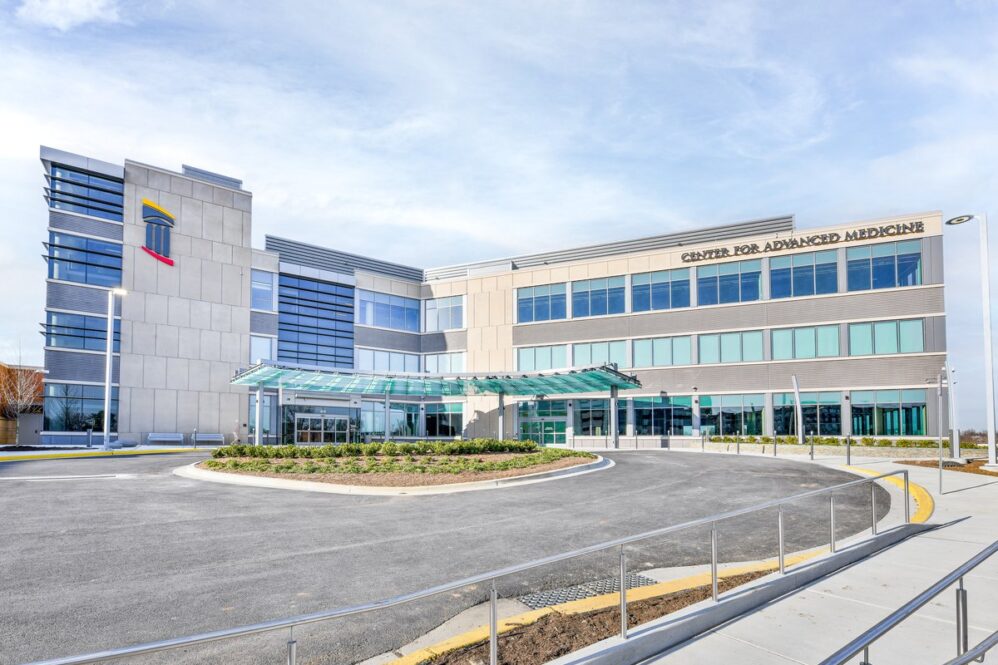WASHINGTON BUSINESS JOURNAL: University of Maryland Capital Region Health is gearing up to unveil an $80 million cancer center on its Largo hospital campus, a care hub the health system is betting will help to change outcomes for its underserved Prince George’s County patients.
The cancer center opens Monday across an initial 35,000 square feet for prevention and screening, diagnosis and treatment, recovery and palliative care. It’s located in the new 100,000-square-foot Center for Advanced Medicine, which broke ground in April 2022, connected to the UM Capital Region Medical Center.
That four-story building devotes two floors to cancer care, and a third to multispecialty clinics including women’s health, heart and vascular, neurosciences, orthopedics, trauma, primary care and outpatient testing — all infrastructure designed to similarly expand access to care for the system’s patients, according to UM Capital. Shell space on the fourth floor could allow the cancer center’s services to grow over time.
That capacity is crucial in the health system’s pursuit to reverse the county’s cancer rates — and related death rates — that sit well above other markets across the country, said Nathaniel Richardson, president and CEO of UM Capital, which is part of Baltimore’s University of Maryland Medical System.
The new center positions UM Capital to catch diseases sooner — from breast to colorectal to prostate to lung cancers — and help patients overcome them, said Richardson, whose sister died at age 46 from a cancer diagnosis “that we thought we had beat.”
“When we can get them in early, that means that we are educating the community… about what to look for, signs and symptoms,” he said. “That’s success to me.”
The project reached the finish line thanks to $67 million from former Maryland Gov. Larry Hogan, which funded the bulk of the project, and another $13 million from UMMS.
Key to the design is a combined exam and consultation room, a living room-type of environment to reduce the anxiety and confusion associated with a cancer diagnosis, said Sarah Larson, UM Capital’s senior director of oncology services. A patient can have that suite for multiple hours, “and instead of them chasing down the providers” and waiting several weeks for those appointments at different sites, she said, they can meet with multiple doctors at one time.
It’s one of the ways UM Capital’s cancer center has the potential to effect change for patients who have had to otherwise get care outside of the county, Larson said. Often as a cancer patient, “you’re coming into an appointment where you have a cancer diagnosis, you’re scared, your family doesn’t know what you’re dealing with — and to top it off, add on the complexity of trying to navigate through a system that’s very fragmented,” said Dr. Melissa Vyfhuis, the cancer center’s medical director of radiation oncology.
UM Capital has provided some cancer services across multiple locations up to this point. But by offering the different elements of cancer care at one location, the system can make treatment simple, efficient and easy for patients to understand, said Vyfhuis, a first-generation immigrant who grew up in the area and has helped family members through their own cancer journeys.
That will also help UM Capital’s team to establish a trustworthy relationship with the Black community, another vital step toward eliminating inequities in the county, said Vyfhuis, also an associate professor of radiation oncology at the University of Maryland School of Medicine.
UM Capital debuts the new hub nearly four years after Richardson took the reins of the Largo hospital in spring 2020. “We did a step back and said, ‘Let’s look at who we want to be when we grow up,’” Richardson said. That ultimately meant transitioning what was historically a critical care, trauma and safety-net hospital to a comprehensive medical center, he said.
That’s crucial for the Prince George’s community, which comprises both affluent residents and those who lack resources, including access to good health care, said Dr. Magesh Sundaram, medical director of cancer services at UM Capital and associate professor of surgery at the University of Maryland School of Medicine.
A cancer center became an essential part of the vision. Prince George’s County suffers from “an asymmetry in the cancer burden,” with high levels of screenings for breast and prostate cancers, but “a much higher mortality rate” as a result of such cancers when compared with the rest of the state, Sundaram said. It also sees disparities between races, with Black men nearly twice as likely to die from prostate cancer than their white counterparts, he said. The solution, he said, is comprehensive cancer care “embedded within the community.”
Because the Largo Cancer Center is hooked into the University of Maryland health system, its team can lean on UMMS specialists already on its campus. That could mean, for instance, consulting a pulmonologist about lung cancer or a gastroenterologist regarding stomach cancer. The system is also striking strategic partnerships, such as with Chesapeake Urology, to bring its doctors to the Largo facility.
UM Capital has tapped a nurse navigator, social worker and clinical trials coordinators, important as people of color continue to be underrepresented in clinical research. It’s also hired an oncology dietician, vital in an area that’s known to be a food desert, Richardson said.
It’s too early to predict how many patients the cancer center will see as it ramps up services, but the system is preparing to have parking capacity for between 150 to 200 patients across services, from medical oncology and radiation oncology to others, he said.
UM Capital Region Medical Center opened in summer of 2021 with a Level 2 trauma center, a 45-treatment bay ER and 205 licensed beds across about 600,000 square feet — replacing Prince George’s Hospital Center in Cheverly, which UMMS took over from Dimensions Healthcare in 2017.
UM Capital has been expanding since then, last year opening a neonatal intensive care unit at that hospital and separately standing up a new medical center in Laurel. It has also been growing its ambulatory footprint, with practice locations in National Harbor, Suitland, Bowie and New Carrollton.
The system rolls out its cancer center as other local health systems similarly invest in expansions and education about screening, and as demand for such care closer to home only increases.









